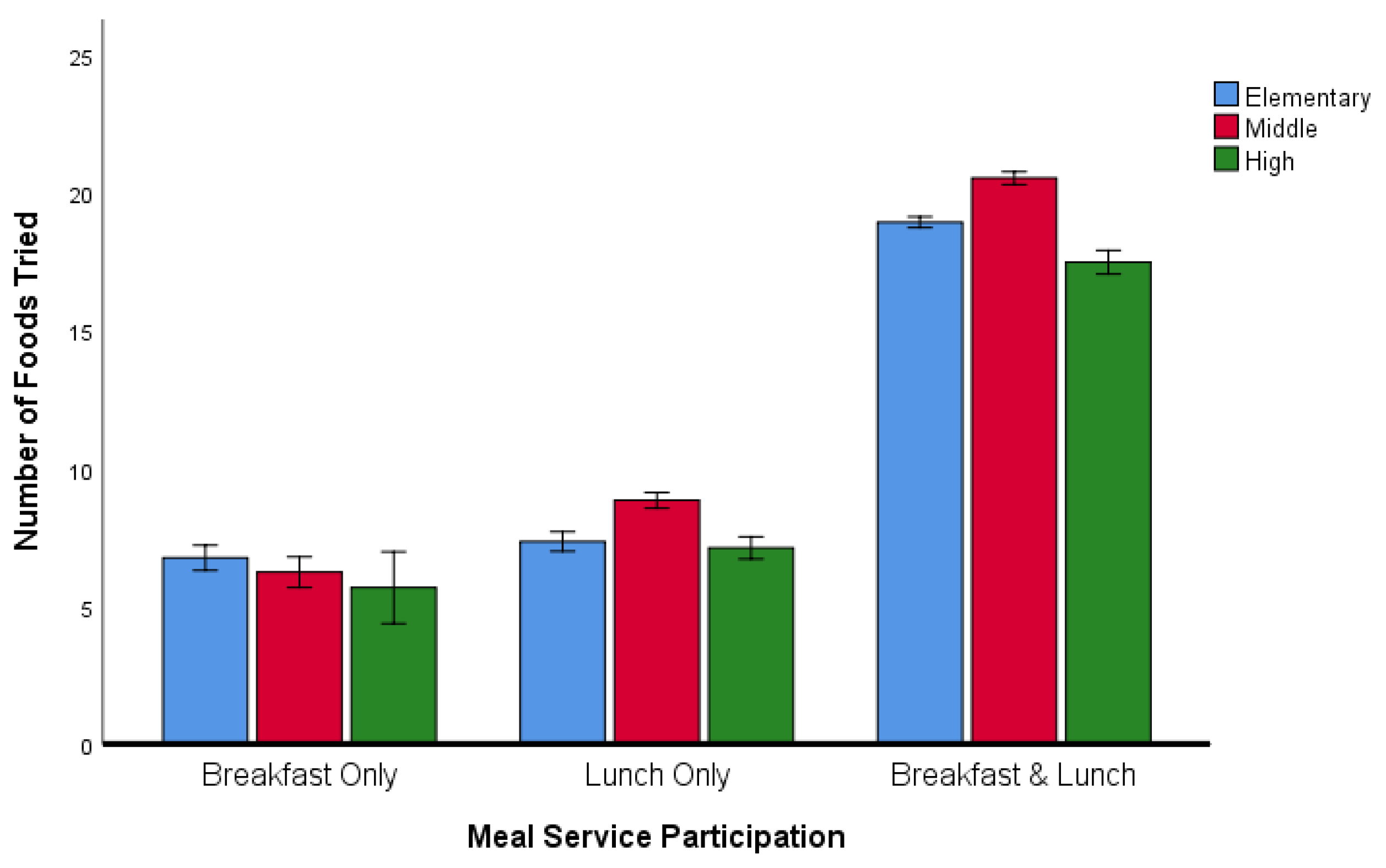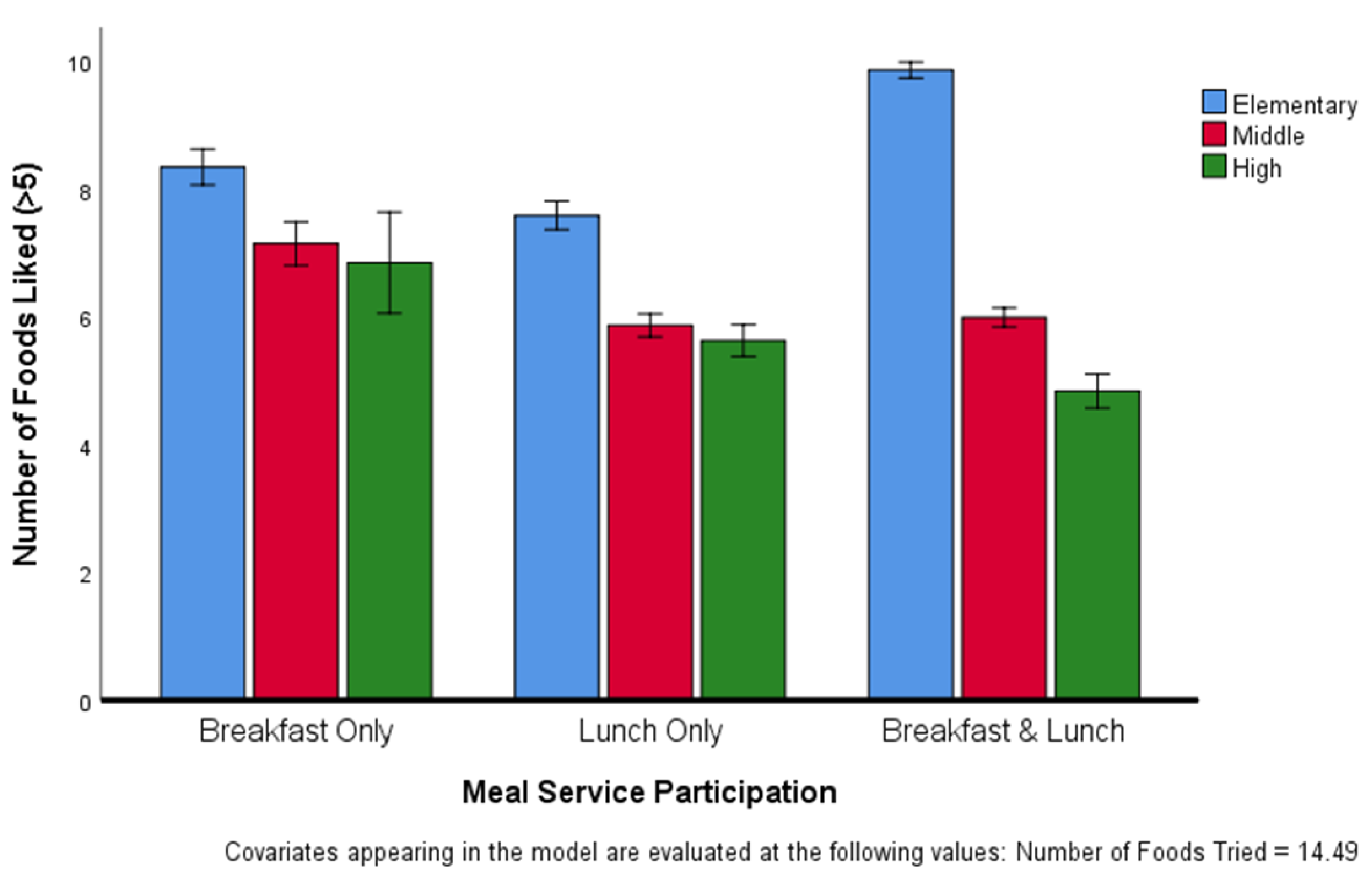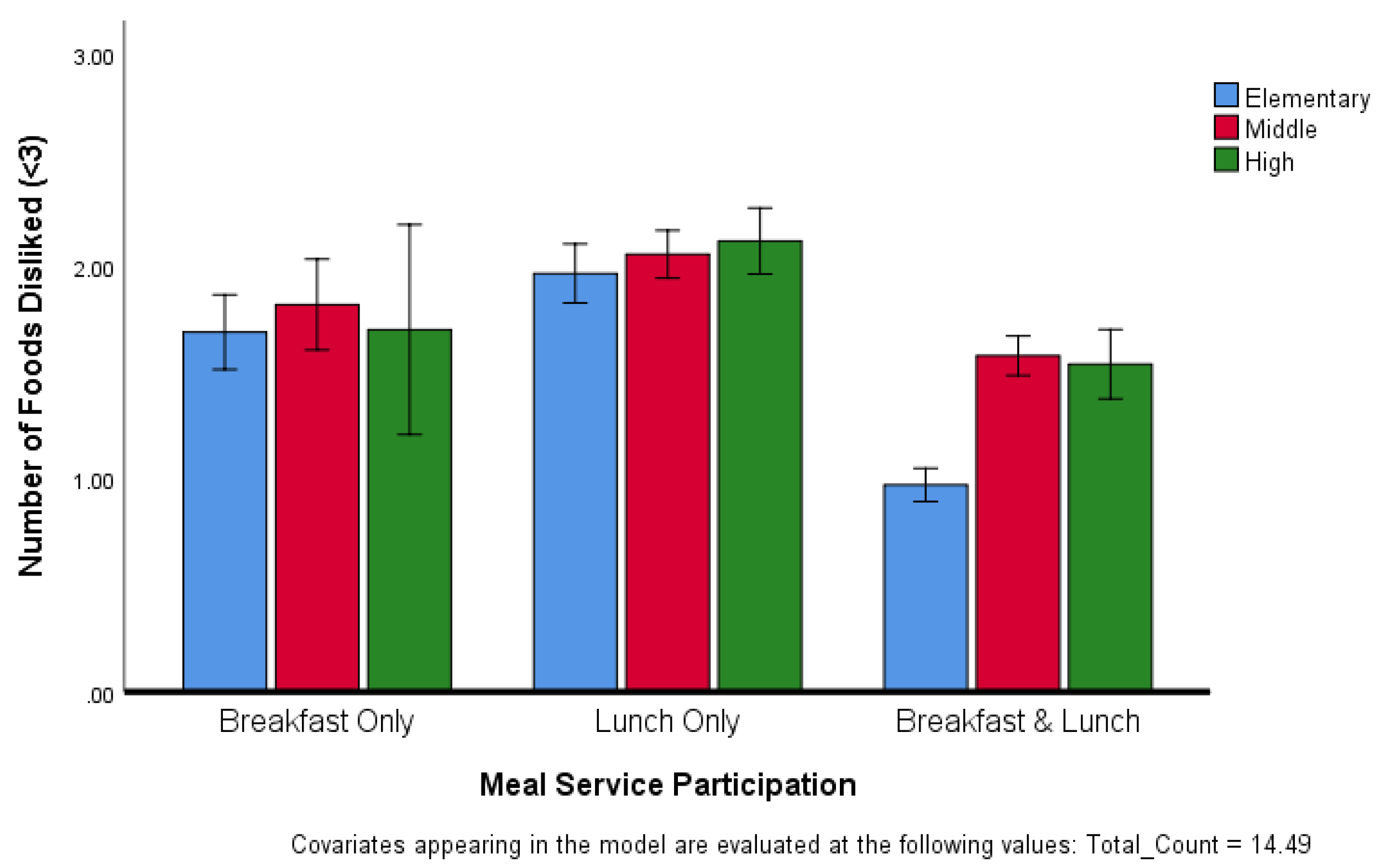Food Trying and Liking Related to Grade Level and Meal Participation
Abstract
1. Introduction
2. Materials and Methods
2.1. Participants
2.2. Survey
2.3. Implementation
2.4. Statistical Analysis
3. Results
3.1. Liking Ratings
3.2. Number of Foods Tried
3.3. Number of Foods Liked
3.4. Number of Foods Disiked
3.5. Satisfaction Scale
4. Discussion
5. Conclusions
Author Contributions
Funding
Acknowledgments
Conflicts of Interest
References
- Gat-Yablonski, G.; Yackobovitch-Gavan, M.; Phillip, M. Which dietary components modulate longitudinal growth? Curr. Opin. Clin. Nutr. Metab. Care 2017, 20, 211–216. [Google Scholar] [CrossRef]
- Das, J.K.; Salam, R.A.; Thornburg, K.L.; Prentice, A.M.; Campisi, S.; Lassi, Z.S.; Koletzko, B.; Bhutta, Z.A. Nutrition in adolescents: Physiology, metabolism, and nutritional needs. Ann. N. Y. Acad. Sci. 2017, 1393, 21–33. [Google Scholar] [CrossRef]
- Asigbee, F.M.; Whitney, S.D.; Peterson, C.E. The link between nutrition and physical activity in increasing academic achievement. J. Sch. Health 2018, 88, 407–415. [Google Scholar] [CrossRef]
- Bailey, R.L.; Catellier, D.J.; Jun, S.; Dwyer, J.T.; Jacquier, E.F.; Anater, A.S.; Eldridge, A.L. Total usual nutrient intakes of US children (under 48 months): Findings from the Feeding Infants and Toddlers Study (FITS) 2016. J. Nutr. 2018, 148, 1557S–1566S. [Google Scholar] [CrossRef]
- Banfield, E.C.; Liu, Y.; Davis, J.S.; Chang, S.; Frazier-Wood, A.C. Poor adherence to US Dietary Guidelines for children and adolescents in the National Health and Nutrition Examination Survey population. J. Acad. Nutr. Diet. 2016, 116, 21–27. [Google Scholar] [CrossRef]
- Cooke, L.J.; Wardle, J.; Gibson, E.; Sapochnik, M.; Sheiham, A.; Lawson, M.; Gibson, E. Demographic, familial and trait predictors of fruit and vegetable consumption by pre-school children. Public Health Nutr. 2004, 7, 295–302. [Google Scholar] [CrossRef]
- Perrine, C.G.; Galuska, D.A.; Thompson, F.E.; Scanlon, K.S. Breastfeeding duration is associated with child diet at 6 years. Pediatrics 2014, 134, S50–S55. [Google Scholar] [CrossRef]
- De Wild, V.W.T.; Jager, G.; Olsen, A.; Costarelli, V.; Boer, E.; Zeinstra, G.G. Breast-feeding duration and child eating characteristics in relation to later vegetable intake in 2–6-year-old children in ten studies throughout Europe. Public Health Nutr. 2018, 21, 2320–2328. [Google Scholar] [CrossRef]
- Bassul, C.; Corish, C.A.; Kearney, J.M. Associations between the home environment, feeding practices and children’s intakes of fruit, vegetables and confectionary/sugar-sweetened beverages. Int. J. Environ. Res. Public Health 2020, 17, 4837. [Google Scholar] [CrossRef]
- Wyse, R.J.; Campbell, E.; Nathan, N.; Wolfenden, L. Associations between characteristics of the home food environment and fruit and vegetable intake in preschool children: A cross-sectional study. BMC Public Health 2011, 11, 938. [Google Scholar] [CrossRef]
- Landry, M.J.; Berg, A.E.V.D.; Asigbee, F.M.; Vandyousefi, S.; Ghaddar, R.; Davis, J.N. Child-report of food insecurity is associated with diet quality in children. Nutrients 2019, 11, 1574. [Google Scholar] [CrossRef] [PubMed]
- Avery, A.; Anderson, C.; McCullough, F. Associations between children’s diet quality and watching television during meal or snack consumption: A systematic review. Matern. Child Nutr. 2017, 13, e12428. [Google Scholar] [CrossRef] [PubMed]
- Datar, A.; Nicosia, N. The effect of state competitive food and beverage regulations on childhood overweight and obesity. J. Adolesc. Health 2017, 60, 520–527. [Google Scholar] [CrossRef] [PubMed][Green Version]
- Martin, J. Leading and managing child nutrition programs for long-term success. In Managing Child Nutrition Programs: Leadership for Excellence, 2nd ed.; Martin, J., Oakley, C.B., Eds.; Jones and Bartlett Learning: Sudbury, MA, USA, 2008; pp. 373–416. [Google Scholar]
- United States Department of Agriculture Economic Research Service. Child Nutrition Programs. Available online: https://www.ers.usda.gov/topics/food-nutrition-assistance/child-nutrition-programs/ (accessed on 20 May 2020).
- Food Research and Action Center. National School Lunch Program: Trends and Factors Affecting Student Participation. Available online: https://frac.org/research/resource-library/national-school-lunch-program-trends-factors-affecting-student-participation (accessed on 20 May 2020).
- Hass, J.; Cunningham-Sabo, L.; Auld, G. Plate waste and attitudes among high school lunch program participants. J. Child Nutr. Manag. 2014, 38. Available online: https://schoolnutrition.org/5--News-and-Publications/4--The-Journal-of-Child-Nutrition-and-Management/Spring-2014/Volume-38,-Issue-1,-Spring-2014---Haas,-Cunningham-Sabo,-Auld/ (accessed on 1 August 2020).
- Handforth, K.M.; Gilboy, M.B.; Harris, J.; Melia, N. Fruit and vegetable plate waste among students in a suburban school district participating in the National School Lunch Program. J. Child Nutr. Manag. 2016, 40. Available online: https://schoolnutrition.org/uploadedFiles/5_News_and_Publications/4_The_Journal_of_Child_Nutrition_and_Management/Spring_2016/7-FruitandVegetablePlateWaste.pdf (accessed on 1 August 2020).
- Yoder, A.B.B.; Foecke, L.L.; A Schoeller, D. Factors affecting fruit and vegetable school lunch waste in Wisconsin elementary schools participating in Farm to School programmes. Public Health Nutr. 2015, 18, 2855–2863. [Google Scholar] [CrossRef]
- Byker, C.J.; Farris, A.R.; Marcenelle, M.; Davis, G.C.; Serrano, E. Food waste in a school nutrition program after implementation of new lunch program guidelines. J. Nutr. Educ. Behav. 2014, 46, 406–411. [Google Scholar] [CrossRef]
- Niaki, S.F.; Moore, C.E.; Chen, T.-A.; Cullen, K.W. Younger elementary school students waste more school lunch foods than older elementary school students. J. Acad. Nutr. Diet. 2017, 117, 95–101. [Google Scholar] [CrossRef]
- Gwozdz, W.; Reisch, L.A.; Eiben, G.; Hunsberger, M.; Konstabel, K.; Kovacs, E.; Luszczki, E.; Mazur, A.; Mendl, E.; Saamel, M.; et al. The effect of smileys as motivational incentives on children’s fruit and vegetable choice, consumption and waste: A field experiment in schools in five European countries. Food Policy 2020. [Google Scholar] [CrossRef]
- DeCosta, P.; Møller, P.; Frøst, M.B.; Olsen, A. Changing children’s eating behavior—A review of experimental research. Appetite 2017, 113, 327–357. [Google Scholar] [CrossRef]
- Kropp, J.D.; Abarca-Orozco, S.J.; Israel, G.D.; Diehl, D.C.; Galindo-Gonzalez, S.; Headrick, L.B.; Shelnutt, K. A plate waste evaluation of the farm to school program. J. Nutr. Educ. Behav. 2018, 50, 332–339.e1. [Google Scholar] [CrossRef] [PubMed]
- Peckham, J.G.; Kropp, J.D.; Mroz, T.; Haley-Zitlin, V.; Granberg, E.M. Selection and consumption of lunches by National School Lunch Program participants. Appetite 2019, 133, 191–198. [Google Scholar] [CrossRef] [PubMed]
- Wills, W.; Danesi, G.; Kapetanaki, A.B.; Hamilton, L. Socio-economic factors, the food environment and lunchtime food purchasing by young people at secondary school. Int. J. Environ. Res. Public Health 2019, 16, 1605. [Google Scholar] [CrossRef] [PubMed]
- Peckham, J.G.; Kropp, J.D.; Mroz, T.A.; Haley-Zitlin, V.; Granberg, E.M.; Hawthorne, N. Socioeconomic and demographic determinants of the nutritional content of National School Lunch Program entrée selections. Am. J. Agric. Econ. 2016, 99, 1–17. [Google Scholar] [CrossRef]
- Łuszczki, E.; Sobek, G.; Bartosiewicz, A.; Baran, J.; Weres, A.; Dereń, K.; Mazur, A. Analysis of fruit and vegetable consumption by children in school canteens depending on selected sociodemographic factors. Medicina 2019, 55, 397. [Google Scholar] [CrossRef]
- Ralston, K.; Newman, C.; Department of Agriculture, Economic Research Service. School Meals in Transition, EIB-143, U.S. Available online: www.ers.usda.gov/webdocs/publications/44003/53570_eib143.pdf?v=106.7 (accessed on 18 July 2020).
- United States Department of Agriculture Food and Nutrition Service. National Level Annual Summary Tables: FY 1969–2019. Available online: https://www.fns.usda.gov/pd/child-nutrition-tables (accessed on 21 May 2020).
- Cooke, L.J.; Wardle, J. Age and gender differences in children’s food preferences. Br. J. Nutr. 2005, 93, 741–746. [Google Scholar] [CrossRef]
- Caine-Bish, N.; Scheule, B. Food preferences of school age children and adolescents in an Ohio school district. J. Child Nutr. Manag. 2007, 31. Available online: https://schoolnutrition.org/uploadedFiles/5_News_and_Publications/4_The_Journal_of_Child_Nutrition_and_Management/Fall_2007/9-caine-bish.pdf (accessed on 24 July 2020).
- Nutrition Standards in the National School Lunch and School Breakfast Programs; Final Rule (7 CFR Parts 210 and 220). Washington, DC: Federal Register, United States Department of Agriculture. Available online: https://www.federalregister.gov/d/2012-1010 (accessed on 21 May 2020).
- Bergman, E.A.; Englund, T.; Weigt Taylor, K.; Watkins, T.; Schepman, S.; Rushing, K. School lunch before and after implementation of the Healthy Hunger-Free Kids Act. J. Child Nutr. Manag. 2014, 38. Available online: https://schoolnutrition.org/uploadedFiles/5_News_and_Publications/4_The_Journal_of_Child_Nutrition_and_Management/Fall_2014/SchoolLunchBeforeandAfterImplementationHealthyHungerFreeKidsAct.pdf (accessed on 24 July 2020).
- Gearan, E.C.; Fox, M.K. Updated nutrition standards have significantly improved the nutritional quality of school lunches and breakfasts. J. Acad. Nutr. Diet. 2020, 120, 363–370. [Google Scholar] [CrossRef]
- Mozer, L.; Johnson, N.B.; Podrabsky, M.; Rocha, A. School lunch entrées before and after implementation of the Healthy, Hunger-Free Kids Act of 2010. J. Acad. Nutr. Diet. 2019, 119, 490–499. [Google Scholar] [CrossRef]
- Swaney-Stueve, M.; Jepsen, T.; Deubler, G. The emoji scale: A facial scale for the 21st century. Food Qual. Prefer. 2018, 68, 183–190. [Google Scholar] [CrossRef]
- Popper, R.; Kroll, J.J. Consumer testing of food products using children. In Developing Children’s Food Products; Kilcast, D., Angus, F., Eds.; Woodhead Publishing: Cambridge, UK, 2011. [Google Scholar]
- Smith, S.; Cunningham-Sabo, L.; Auld, G. Satisfaction of middle school lunch program participants and non-participants with the school lunch experience. J. Child Nutr. Manag. 2015, 39. Available online: https://schoolnutrition.org/uploadedFiles/5_News_and_Publications/4_The_Journal_of_Child_Nutrition_and_Management/Fall_2015/SatisfactionofMiddleSchoolLunchProgramParticipantsandNonParticipantswiththeSchoolLunchExperience.pdf (accessed on 24 July 2020).
- Farris, A.R.; Misyak, S.A.; Duffey, K.J.; Mann, G.; Davis, G.C.; Hosig, K.; Atzaba-Poria, N.; McFerren, M.M.; Serrano, E. A comparison of fruits, vegetables, sugar-sweetened beverages, and desserts in the packed lunches of elementary school children. Child. Obes. 2015, 11, 275–280. [Google Scholar] [CrossRef] [PubMed]
- Izumi, B.T.; Eckhardt, C.L.; Hallman, J.A.; Herro, K.; Barberis, D.A. Harvest for Healthy Kids Pilot Study: Associations between exposure to a farm-to-preschool intervention and willingness to try and liking of target fruits and vegetables among low-income children in Head Start. J. Acad. Nutr. Diet. 2015, 115, 2003–2013. [Google Scholar] [CrossRef] [PubMed]
- Lakkakula, A.; Geaghan, J.P.; Wong, W.-P.; Zanovec, M.; Pierce, S.H.; Tuuri, G. A cafeteria-based tasting program increased liking of fruits and vegetables by lower, middle and upper elementary school-age children. Appetite 2011, 57, 299–302. [Google Scholar] [CrossRef] [PubMed]
- Lakkakula, A.; Geaghan, J.; Zanovec, M.; Pierce, S.; Tuuri, G. Repeated taste exposure increases liking for vegetables by low-income elementary school children. Appetite 2010, 55, 226–231. [Google Scholar] [CrossRef]



| Grade Group | ||||||||||
| Elementary | Middle | High | ||||||||
| Item | Mean | n | SD | Mean | n | SD | Mean | n | SD | p-Value |
| Food from home | 6.35 a | 6450 | 1.08 | 6.38 a | 5076 | 0.98 | 6.23 b | 1610 | 1.00 | p < 0.001 |
| Breakfast | 5.80 a | 7659 | 1.09 | 5.14 b | 5537 | 1.21 | 5.05 c | 1531 | 1.19 | p < 0.001 |
| Lunch | 5.60 a | 8485 | 1.24 | 4.87 b | 7834 | 1.29 | 4.61 c | 2983 | 1.25 | p < 0.001 |
| Fruit | 5.71 a | 9731 | 1.55 | 4.93 b | 8668 | 1.62 | 4.91 b | 3141 | 1.53 | p < 0.001 |
| Cold vegetables | 3.82 a | 9731 | 2.09 | 3.48 c | 8668 | 1.81 | 3.71 b | 3141 | 1.76 | p < 0.001 |
| Hot vegetables | 3.23 a | 9731 | 2.01 | 2.74 c | 8668 | 1.68 | 2.98 b | 3141 | 1.69 | p < 0.001 |
| Participation Level | ||||||||||
| Breakfast only | Lunch only | Breakfast and Lunch | ||||||||
| Item | Mean | n | SD | Mean | n | SD | Mean | n | SD | p-Value |
| Food from home | 6.44 a | 1651 | 1.03 | 6.26 c | 3725 | 1.05 | 6.37 b | 7760 | 1.02 | p < 0.001 |
| Breakfast | 5.58 a | 2209 | 1.19 | na | na | na | 5.45 b | 12518 | 1.20 | p < 0.001 |
| Lunch | na | na | na | 4.97 b | 6737 | 1.34 | 5.24 a | 12565 | 1.30 | p < 0.001 |
| Fruit | 5.08 b | 2231 | 1.77 | 5.05 b | 6470 | 1.57 | 5.44 a | 12569 | 1.61 | p < 0.001 |
| Cold vegetables | 3.41 c | 2231 | 1.99 | 3.57 b | 6470 | 1.82 | 3.77 a | 12569 | 1.99 | p < 0.001 |
| Hot vegetables | 2.76 c | 2231 | 1.82 | 2.85 b | 7113 | 1.71 | 3.11 a | 12569 | 1.92 | p < 0.001 |
 ), 2 (
), 2 ( ), 3 (
), 3 ( ), 4 (
), 4 ( ), 5 (
), 5 ( ), 6 (
), 6 ( ), 7 (
), 7 ( ). 2. Mean values within a row with unlike letters were significantly different (p < 0.05).
). 2. Mean values within a row with unlike letters were significantly different (p < 0.05).© 2020 by the authors. Licensee MDPI, Basel, Switzerland. This article is an open access article distributed under the terms and conditions of the Creative Commons Attribution (CC BY) license (http://creativecommons.org/licenses/by/4.0/).
Share and Cite
Hanson, J.; Elmore, J.; Swaney-Stueve, M. Food Trying and Liking Related to Grade Level and Meal Participation. Int. J. Environ. Res. Public Health 2020, 17, 5641. https://doi.org/10.3390/ijerph17165641
Hanson J, Elmore J, Swaney-Stueve M. Food Trying and Liking Related to Grade Level and Meal Participation. International Journal of Environmental Research and Public Health. 2020; 17(16):5641. https://doi.org/10.3390/ijerph17165641
Chicago/Turabian StyleHanson, Jennifer, Janelle Elmore, and Marianne Swaney-Stueve. 2020. "Food Trying and Liking Related to Grade Level and Meal Participation" International Journal of Environmental Research and Public Health 17, no. 16: 5641. https://doi.org/10.3390/ijerph17165641
APA StyleHanson, J., Elmore, J., & Swaney-Stueve, M. (2020). Food Trying and Liking Related to Grade Level and Meal Participation. International Journal of Environmental Research and Public Health, 17(16), 5641. https://doi.org/10.3390/ijerph17165641





